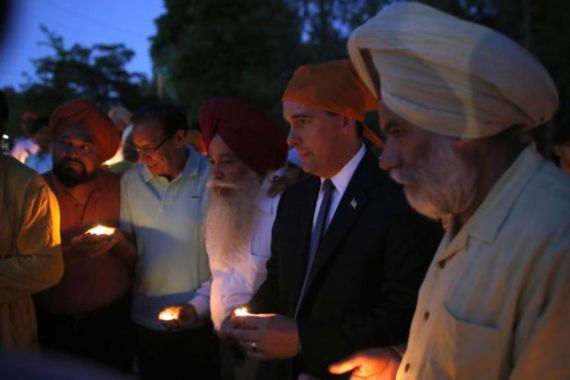Communities of colour remain under attack
A collective resistance must be forged in opposing hate crimes like the shooting in Oak Creek, writes Bindra.

On Sunday, a gunman entered the gurdwara in Oak Creek, Wisconsin, and opened fire, killing six people and wounding three. Reported as a hate crime, the incident serves as the latest account of the pervasive harassment, discrimination, assault and murder plaguing communities of colour in the US today.
As the contemporary, state-manufactured discourse surrounding the war of terrorism continues to demonise Muslims and Arabs, communities of colour remain under attack. Yet the fear and hysteria caused by those now-familiar narratives of suspicious and threatening turbaned men with dark skin and long beards not only justifies wars abroad and violence at home, but also works to exasperate cleavages within communities of colour, pitting minority groups against each other through the construction of the “good” or “bad” minority citizen.
For people of colour implicated in the “terrorist” stereotype through physical markers of cultural and religious identity like the turban or the veil, one “other” will not hesitate to further differentiate itself from those who have also been termed “other” as a matter of survival.
This was the case when the killing of a Sikh-American man was widely publicised in 2001, four days after the September 11 attacks.
Hate crime
On September 15, 2001, Balbir Singh Sodhi was planting flowers around the edges of the Chevron gas station he owned in Mesa, Arizona, when Frank Roque, aimed his .38 calibre handgun in the direction of Sodhi’s back through the window of his truck. Roque hit Sodhi with five bullets and killed him instantly. Roque drove onto the house he had previously sold to an Afghani-American couple, firing shots there, as well as at a nearby Mobil gas station, where he targeted Lebanese-American Anwar Khalil. He finally stopped to visit a local sports bar where he announced, “They’re investigating the murder of a turban-head down the street”.
Earlier on the day of shooting, Sodhi had purchased an American flag from Costco and donated $75 to a Red Cross emergency fund dedicated to the relief workers of Ground Zero.
The Maricopa County attorney, Rick Romley, said “Sodhi was apparently killed for no other reason than because he was dark-skinned, bearded and wore a turban.”
| US police probe Sikh temple gunman’s links |
I remember that night well. My father, Sikh himself, came home to the New Jersey suburb where my family spent the Bush years and watched the news. After hearing Sodhi’s death, he called the nightly news broadcast and tried to politicise the event, explaining who Sikhs were and how we were different from Muslims.
He wasn’t able to address the problematic foundation of branding Arabs or Muslims as terrorists in the first place, but instead was placed in a situation where the only immediate response to the urgency of the situation was to say, “We’re not them”.
In the months following 9/11, reported anti-Muslim hate crimes rose 1,700 per cent, according to Human Rights Watch. In the broader context of post-9/11 security measures, the suspension of constitutional rights for immigrants and migrants without status, the excessive surveillance of brown and black bodies, the Sikh community’s desire to distinguish itself as a distinct minority group separate from the larger targeted minority group, Muslims, was understandable.
The organising efforts of the Sikh community after Sodhi’s death focused on dispelling myths about Sikhism, helping to distinguish for others one “towelhead” or “diaper”, as US Rep John Cooksey referred to the turban, from another. Sikh groups held parades, vigils, and met with senators and members of Congress to honour the victims of recent hate crimes and promote the portrayal of Sikh-Americans as dutiful, law-abiding and America-loving citizens.
‘Docile patriotism’
The production of what is referred to as “docile patriotism” by Jasbir K Puar and Amit S Rai pits communities of colour against each other as they opt to become servants rather than suspects of the state. This is especially troublesome for Sikhs and Muslims who already share a historical legacy of animosity and violence between themselves.
It is clear that Frank Roque killed Balbir Singh Sodhi in 2001, seeking revenge for the attacks of 9/11. The motives behind the shooting at the gurdwara in Oak Creek more than 10 years later remain unclear. Whether the killer was able to distinguish one turban from another or one place of worship from another, the point was made clear: we are still not welcome, we are still not wanted, we are still different.
However docile one is, however steadfast one’s allegiance is to the state, the model minority citizenship is unattainable. Yet communities of colour continue to self-monitor and self-regulate the boundaries of their own communities at the expense of formulating strategies for collective social action and change.
The shooting at the gurdwara should not be thought of as only a Sikh or a Muslim problem. It is a collective one. The brutal murder of Shaima Alawadi, an Iraqi-American and mother of five, a few months ago, or more recently, Chavis Carter in Arkansas, as well as the countless others that have fallen under the state’s supposed law-and-order measures when crossing the border must be regarded the same way.
I hope that next Sunday, in gurdwaras all over the world, Sikhs will grieve the loss in our community. I hope we will be able to sit together, grounded equally on the floor and meditate on the larger implications of the shooting. I hope we will not be afraid to realise the need to reimagine the politics of solidarity. We all have different struggles, but we struggle nonetheless. A collective resistance must be forged in opposing hate crimes like the shooting in Oak Creek. We can’t afford not to.
Tanya Kaur Bindra is a writer and photographer based in Dakar, Senegal. She is a graduate of McGill and University of Toronto.
